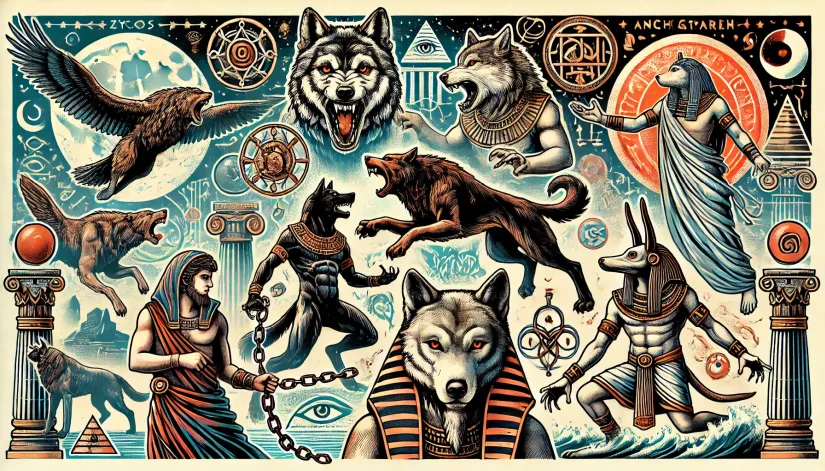Werewolves have captivated human imagination for centuries, appearing in various forms across different cultures and time periods. These shapeshifters—often depicted as humans transforming into wolves—feature prominently in mythology, literature, and history.
But since mythology is the root of most of these legends, we’ve put together a comprehensive list of some of the most famous werewolves in mythology.
From the Greek king Lycaon to the fearsome Fenrir of Norse legend, these stories have left an indelible mark on folklore and continue to inspire retellings of transformation and terror.
In this article:
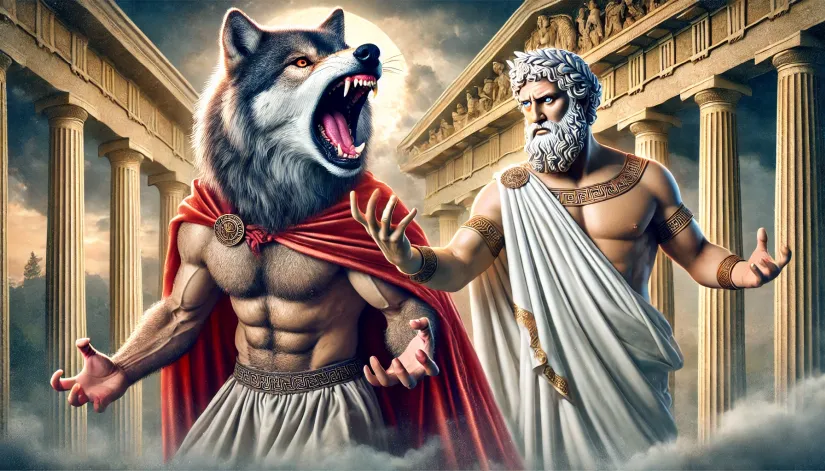
Lycaon: The Greek King Turned Wolf
Origin: Greek mythology.
Transformation Trigger: Served Zeus a meal of human flesh.
Punishment: Turned into a wolf by Zeus.
Moral Lesson: Warns against impiety and trickery towards the gods.
Lycaon—a king of Arcadia in Greek mythology—is one of the most famous werewolves in mythology. His legend is detailed in many ancient (and modern) sources, but you can find the original version in Ovid’s “Metamorphoses.”
So what’s this legend all about? According to the myth, Lycaon attempted to deceive Zeus by serving him a meal prepared from human flesh. He wanted to test Zeus to see if he was truly an all-knowing god.
Outraged by this horrific act, Zeus transformed Lycaon into a wolf as a severe punishment.
The story of Lycaon is significant as it is one of the earliest recorded instances of human-to-wolf transformation.
It’s also beautiful because it blends themes of divine retribution and the implication of hospitality while serving as a moral lesson against impiety and hubris.
Oh, and one more thing. Lycaon’s legend has echoed in several later tales of werewolves (particularly in European history and folklore).
For instance, Peter Stumpp (known as the “Werewolf of Bedburg“) confessed under torture to being a werewolf, committing heinous crimes, and transforming into a wolf with the help of a magical belt given to him by the Devil.
Similar themes appear in the cases of Jacques Roulet, Gilles Garnier, and the werewolf witch trials of the 16th and 17th centuries, where individuals were accused of transforming into wolves and committing atrocities.
And just like in Lycaon’s story, these transformations were seen as a form of divine or diabolical punishment.
Lang Ren: Guardians of Chinese Mythology
Origin: Chinese mythology
Transformation: Result of magical practices or curses.
Abilities: Shapeshift at will.
Role: Often depicted as guardians or protectors.
Do you like reading facts about werewolves? Well, here’s an interesting one for you: In Chinese mythology, there are tales of humans transforming into wolves, often as a result of magical practices or curses.
These creatures, known as Lang Ren, were believed to be able to shapeshift at will.
However, unlike the malevolent werewolves found in Western myths, Lang Ren was often depicted as guardians or protectors, similar to the wolf totems in other cultures.
They were thought to possess not only the physical traits of wolves but also their loyalty and protective instincts.
Damarchus
Origin: Greek mythology.
Ritual: Tasted human entrails mixed with animal flesh.
Duration: Transformed into a wolf for nine years.
Cultural Insight: Reflects Greek beliefs in divine retribution.
Why is Damarchus one of the most famous werewolves in mythology? Because Damarchus—another notable figure from ancient Greek mythology—has one of the wildest werewolf tales.
He was a boxer who got caught up in a strange ritual that involved eating a mix of human entrails and animal flesh. Pretty gross, right? As punishment, the gods turned him into a wolf for nine years.
But Damarchus’ transformation isn’t just about punishment. It’s also about sin and the blurred boundary between human and beast.
In fact, that’s a common occurrence in Greek myths. They often used stories like this to teach lessons about respecting the gods.
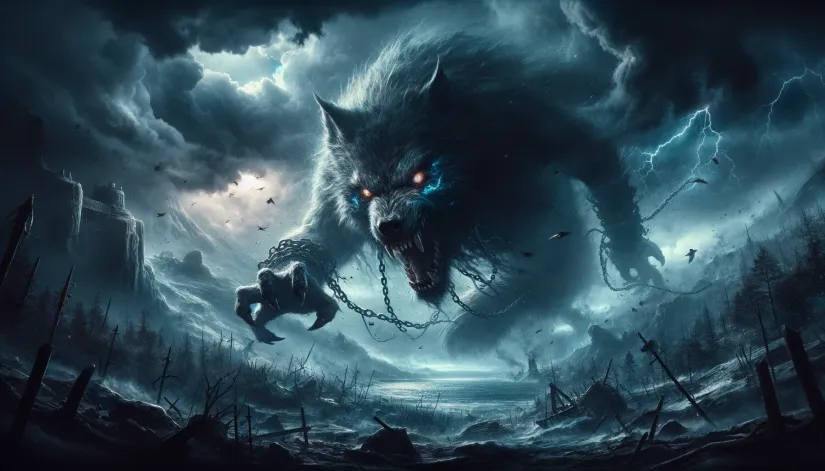
Famous Werewolves in Mythology: Fenrir
Origin: Norse mythology.
Parentage: Offspring of Loki and giantess Angrboda.
Prophecy: Key player in Ragnarok, destined to devour Odin.
Imprisonment: Chained by the gods until Ragnarok.
We continue our list of the most famous werewolves in mythology with Fenrir (also known as Fenrisúlfr or the “Fenris Wolf”), one of the most fearsome creatures in Norse mythology.
He is the offspring of the trickster god Loki and the giantess Angrboda, making him the brother of Hel and the Midgard Serpent, Jörmungandr.
Fenrir’s significance in Norse myth is profound. He is prophesied to play a crucial role in Ragnarok, the end of the world. According to these myths, Fenrir will break free from his chains and consume Odin, the chief of the gods.
This catastrophic event is a pivotal part of the apocalyptic battle that will lead to the death of many gods and the rebirth of the world.
The gods, aware of the prophecies foretelling Fenrir’s role in their doom, attempted to bind him with various fetters.
Related:
- The Smiling Man: A Terrifying Urban Legend from Seattle
- Lizzie Borden’s Trial: Fact vs. Fiction—What Really Happened?
But after breaking two sets of chains, they commissioned the dwarfs to create Gleipnir, a magical ribbon made from six impossible things: the sound of a cat’s footfall, the beard of a woman, the roots of a mountain, the sinews of a bear, the breath of a fish, and the spittle of a bird.
Although Gleipnir appeared thin and delicate, it was incredibly strong.
To trick Fenrir into being bound by Gleipnir, the gods asked him to test his strength against it, assuring him that it was just a game.
Fenrir, wary of their intentions, agreed only if one of the gods would place their hand in his mouth as a pledge of good faith.
Týr, the god of war, courageously offered his hand, which Fenrir bit off when he realized he had been deceived and could not break free.
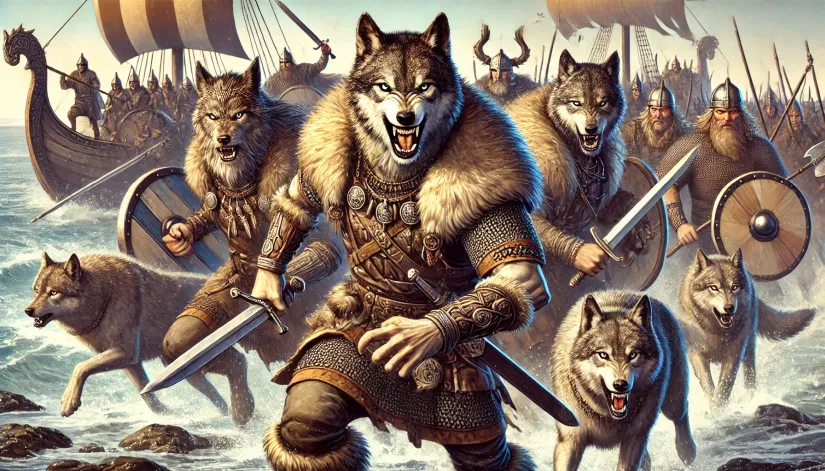
The Wolf Warriors of Norse Legend
Origin: Norse mythology.
Warrior Class: Norse warriors who wore wolf skins.
Attributes: Possessed the strength and ferocity of wolves.
Comparison: Similar to berserkers but associated with wolves.
Ulfhednar were some of the most hardcore warriors in Norse mythology, feared for their wild and fearless fighting style.
While they might not be as well-known as some, let’s say, famous werewolves in movies and television, their legendary status in mythology is undeniable.
Picture this: instead of wearing traditional armor, these guys draped themselves in wolf pelts. Basically, they were the “wolf equivalent” of the berserkers (who wore bear skins and channeled bear-like rage).
Donning these wolf skins was how these warriors believed they could tap into the wolves’ raw power and agility, making them nearly unstoppable in battle. And when in battle, they would enter a trance-like state, almost like they were possessed by the spirit of the wolf.
According to legends, Ulfhednar fought for Odin—the chief of the gods— and were a significant part of his elite forces.
Plus, these Norse warriors profoundly influenced European folklore and many fantastic medieval stories (like the incredible tales of Vseslav of Polotsk and Thiess of Kaltenbrun).

Luperci: Wolf Priests of Ancient Rome
Origin: Roman mythology.
Festival: Participated in the Lupercalia festival.
Attire: Wore wolf skins during rituals.
Purpose: Ensured fertility and warded off evil spirits.
Have you ever heard of Luperci? They were priests of the god Faunus— who played a prominent role in the ancient Roman festival of Lupercalia.
The festival (held annually on February 15) was one of Rome’s oldest and most celebrated rituals to ward off evil spirits.
The Luperci would gather at the Lupercal, a cave on the Palatine Hill where, according to legend, Romulus and Remus were nursed by a she-wolf.
There, they would perform different rituals. The first was an animal sacrifice—typically of several goats and a dog.
The sacrificed animals’ blood was then smeared on the foreheads of two young men (who were subsequently wiped clean with wool soaked in milk, after which they were required to laugh, symbolizing purification and renewal).
The priests would then wear the skins of the sacrificed goats and run around the Palatine Hill, striking bystanders, particularly women, with strips of goat hide (known as februa).
This bizarre ritual links the Luperci with the shapeshifting nature of werewolves (and other similar creatures).
Romulus and Remus
Origin: Roman mythology
Upbringing: Raised by a she-wolf.
Symbolism: Represents strength, ferocity, and protection.
Cultural Significance: Integral to the foundation myth of Rome.
The myth of Romulus and Remus—the founders of Rome—is deeply intertwined with the symbol of the she-wolf in Roman culture.
According to legend, Romulus and Remus were twin brothers abandoned at birth and left to die by the Tiber River.
However, they were miraculously saved and suckled by a she-wolf in a cave known as the Lupercal. (Yes, it’s the same place we mentioned above when discussing Luperci.)
This she-wolf cared for them until they were discovered by a shepherd named Faustulus, who then raised them with his wife, Acca Larentia.
The she-wolf (or lupa) is a powerful emblem in Roman mythology, representing the fierce protection and nurturing the wolf provided to the twins.
Now, while Romulus and Remus are not werewolves, their association with the she-wolf and their upbringing by this mythical creature emphasize the significance of wolves in Roman culture, mirroring the protective and warrior-like attributes revered by the Romans.
This myth also resonates with modern tales of famous werewolves in literature and media, where the wolf’s attributes of strength and savagery are often highlighted.
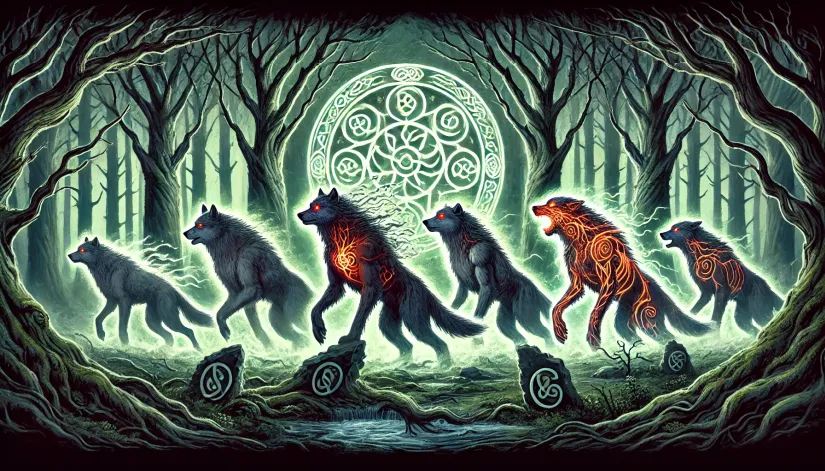
The Werewolves of Ossory
Origin: Irish mythology.
Curse: Transformed into wolves temporarily.
Consciousness: Retained human intelligence during transformation.
Cultural Impact: Influenced Irish folklore and European werewolf legends.
When we talk about famous werewolves in mythology, we are not just talking about Greek, Norse, or Roman legends. Other cultures have their legends, too.
For example, according to an old Irish legend, the people of Ossory were cursed to transform into wolves.
However, these transformations were only temporary, and the individuals retained their human intelligence and consciousness while they were wolves.
The origin of this myth can be traced back to the medieval Irish work “Cóir Anmann,” which tells the story of Laignech Fáelad, a legendary warrior who could transform into a wolf.
Recommended read:
- Is the Grootslang Real? Discover The Legendary Beast of Africa
- The Smiling Man: A Terrifying Urban Legend from Seattle
- Lizzie Borden’s Trial: Fact vs. Fiction—What Really Happened?
His descendants were believed to possess the same ability, linking the werewolves of Ossory to the region’s royal lineage.
The myth was further popularized by narratives such as “De Mirabilibus Hibernie” and “De Ingantaib Érenn,” which describe men who could transform into wolves and leave their human bodies behind.
They would gain some powers (like increased strength and agility), but there was also a downside: injuries sustained in wolf form would also appear on their human bodies.
The 12th-century work “Topographia Hibernica” by Gerald of Wales adds a Christian dimension to the legend.
The writings describe how Saint Patrick cursed a clan that opposed his teachings, transforming them into wolves as divine punishment.
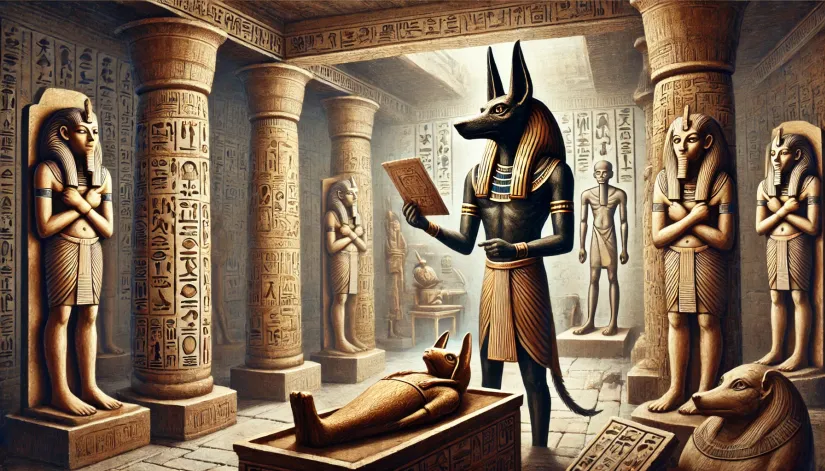
Anubis
Origin: Egyptian mythology.
Depiction: God with the head of a jackal or wolf.
Role: Protector of the dead and god of mummification.
Connection: Links to human-animal transformation concepts.
While not a werewolf in the traditional sense, many still classify Anubis as one of the most famous werewolves in mythology.
Anubis is the ancient Egyptian god of mummification and the afterlife— depicted with the head of a jackal or a wolf (symbolizing both decay and regeneration).
He is responsible for guiding souls to the afterlife and overseeing the weighing of the heart ceremony—in which the deceased’s heart is measured against the feather of Ma’at (the goddess of truth and justice).
This process determined the soul’s worthiness to enter the afterlife.
Anubis’ origins can be traced back to the earliest dynasties of Egypt, where he was initially associated with the afterlife before being overshadowed by Osiris.
Despite this, Anubis retained a crucial role as the god who invented embalming and continued to oversee the preservation of bodies for their journey into the afterlife.
No wonder “Anubis” is still among the most used werewolf names in literature, film, television, and even many video games.
Bisclavret: A Tale of Betrayal and Transformation
Origin: Breton mythology.
Transformation: Turns into a wolf three days a week.
Conflict: Wife steals his clothes to keep him in wolf form.
Resolution: His loyalty and nobility are eventually recognized by the king.
The old Bretons also had one of the most famous werewolves in mythology, Bisclavret.
Bisclavret is a werewolf from a medieval Breton lai (poem) by Marie de France in the 12th century.
The story revolves around a nobleman who transforms into a wolf three days a week. His wife (upon discovering his secret) steals his clothes to prevent him from changing back into a human.
Eventually, the king recognizes Bisclavret’s loyalty and noble nature, leading to his restoration and the punishment of his unfaithful wife.
Notably, the lai of Bisclavret differs from other werewolf tales of the time (like “Melion” and “Werewolves of Ossory”) by portraying the werewolf sympathetically, focusing on his human qualities even in his wolf form.
The Epic of Gilgamesh
Origin: Mesopotamian mythology.
Transformation Trigger: Goddess Ishtar’s punishment.
Victim: Shepherd who loved Ishtar.
Theme: Divine punishment and transformation.
Believe it or not, the “Epic of Gilgamesh” (one of the oldest known pieces of literature) contains an early reference to werewolves.
Gilgamesh (the hero of the epic) rejects Ishtar’s advances. He fears that any relationship with the goddess could end up tragically, just as it happened to all her previous lovers who suffered a terrible faith. (For example, Ishtar transformed a shepherd who once loved her into a wolf, cursed to be hunted by his own dogs and shunned by his community.)
Ishtar’s transformation of the shepherd is not just a random act of vengeance but a calculated punishment designed to strip him of his identity and place in society. By turning him into a wolf, Ishtar condemns him to a life of isolation and perpetual danger.
Of course, the hero, Gilgamesh, wants nothing to do with that.
This ancient narrative from the “Epic of Gilgamesh” provides one of the earliest examples of the werewolf motif in literature, influencing countless subsequent stories in mythology, folklore, and popular culture.
Today’s famous werewolves in movies and television include characters from the Harry Potter series, the Twilight saga, and the TV show Teen Wolf.
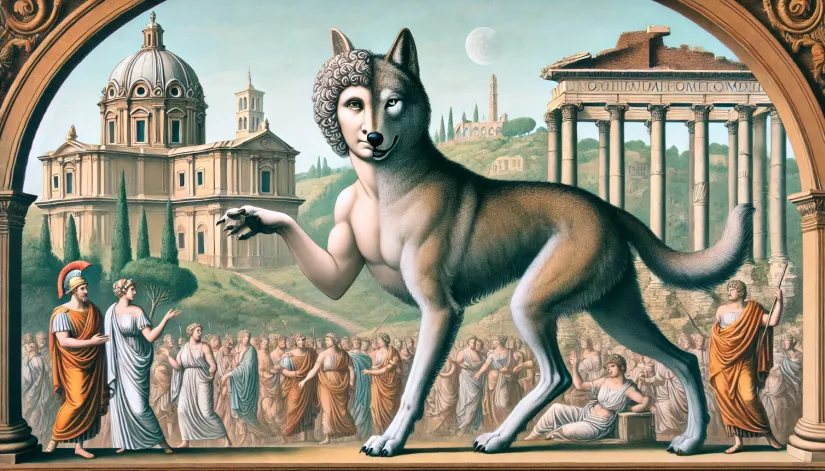
Versipellis
Origin: Roman mythology
Term Meaning: “Turn-skin” in ancient Rome.
Ability: Transform into animals, including wolves.
Belief: Highlights Roman views on magical shapeshifting.
The term “versipellis” (which translates to “turn-skin”) was used in ancient Rome to describe individuals who could transform into animals, including wolves.
This concept is frequently mentioned in Roman literature. For instance, in Petronius’s “Satyricon,” there’s a tale of a soldier who transforms into a wolf.
But the idea of people turning into beasts isn’t just confined to myths and legends. It was deeply rooted in everyday folklore (and history), with many people claiming to encounter individuals who could change their form at will.
A great example (though from a different region) is the Beast of Gévaudan. In French folklore, the Beast of Gévaudan was an unknown creature that terrorized the region in the 18th century.
The true nature of this monster is still debated, but the attacks were very real. However, some associate the Beast of Gévaudan with one of the best-documented werewolf cases in history.
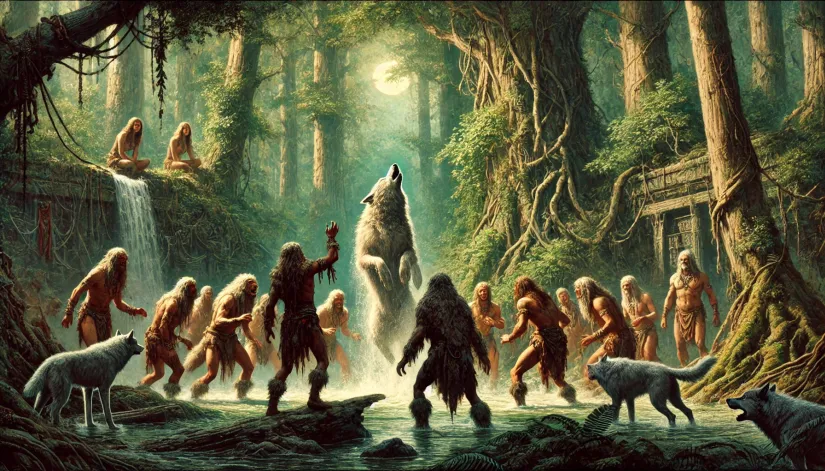
The Mysterious Neuri
Origin: Greek mythology
Annual Transformation: Turn into wolves once a year.
Historical Reference: Mentioned by Herodotus.
Concept: Community of shapeshifters
The Neuri (some of the most famous werewolves in mythology) were an ancient tribe described by Herodotus in his work “The Histories.” They lived near Scythia—in what is now considered the region of Poland and Lithuania, around the river basin of the Bug.
According to Herodotus, the Neuri were a nomadic people. One of their most fascinating traits was the belief that they could transform into wolves for a few days once a year.
Herodotus included this account among his descriptions of various peoples and cultures he encountered or learned about through his travels and studies.
He reported that the Neuri were driven from their homeland by an invasion of serpents, which led them to seek refuge among the Scythians (The Histories, Book 4).
Despite the fantastical elements of their alleged lycanthropy, Herodotus remained somewhat skeptical about the physical transformation aspects.
Asena: The She-Wolf of Turkic Lore
Origin: Turkic mythology.
Depiction: Mythological she-wolf.
Role: Nursed and protected a young boy, progenitor of the Turkic peoples.
Theme: Significant human-wolf interaction and transformation.
We conclude our list of some of the most famous werewolves in mythology with Asena, a prominent figure in Turkic lore.
According to the legend, a young boy, the sole survivor, is found and nurtured by Asena after a devastating battle. This she-wolf nurses the injured boy, ensuring his survival.
Eventually, the boy grows up and founds the Ashina clan, which later leads the Göktürks, one of the major Turkic tribes.
The Asena myth is among the oldest in Turkic mythology, dating back to at least 330 BC.
The wolf, particularly the grey wolf (Böri), holds a sacred place in Turkic beliefs. It symbolizes war, freedom, and guidance. It’s believed that a wolf would appear to lead and protect the Turkic people in times of crisis.
For instance, the Yakut people consider the wolf their guardian, and many Turkic tribes believed that carrying a wolf tooth could protect them from harm.

